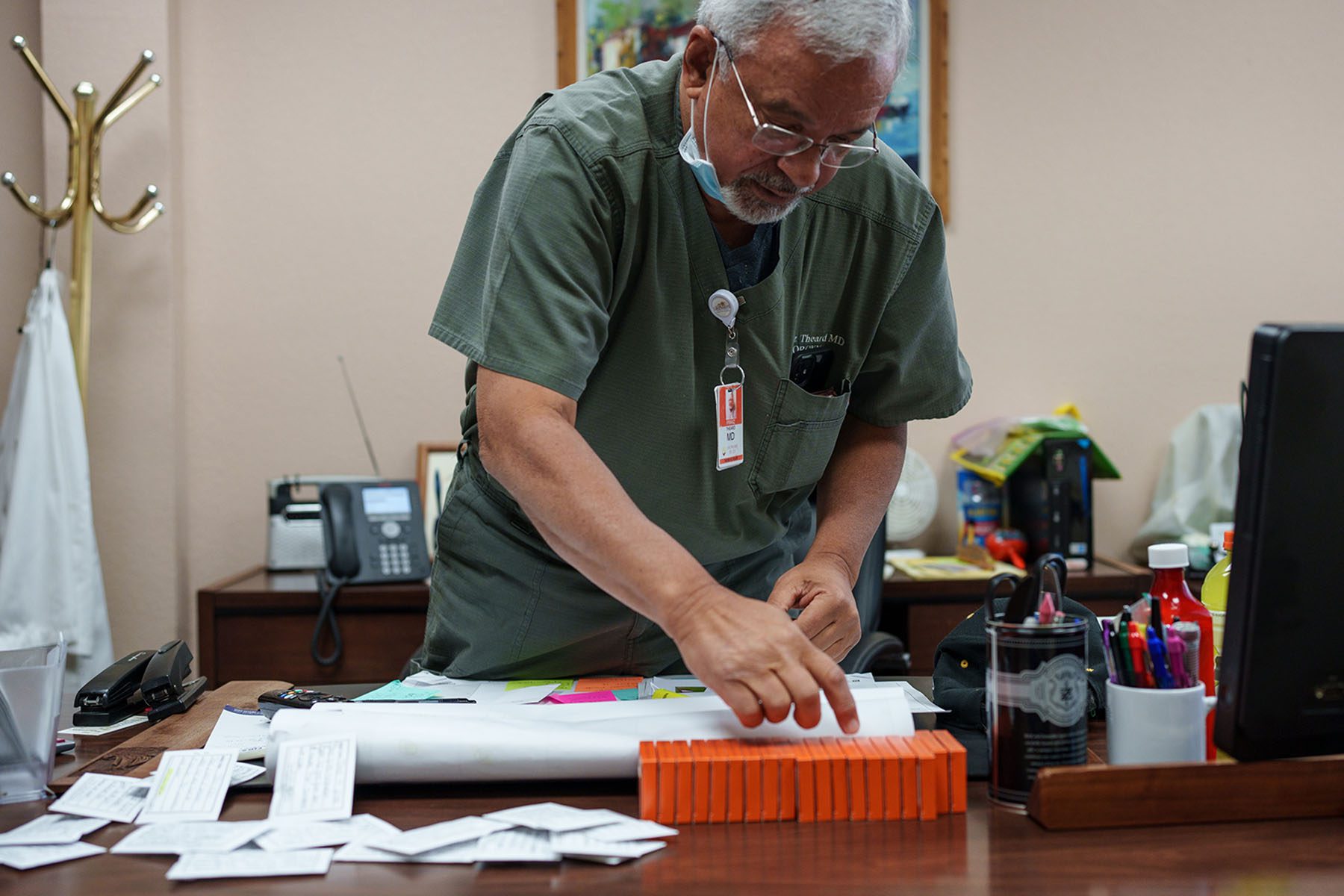In the wake of the leak of a Supreme Court draft opinion that would overturn Roe v. Wade, reproductive justice organizers and some medical providers have already seen a surge in interest in self-managed abortion. For most people, this means trying to access and take the same medications utilized in a medication abortion — something that is legal in all 50 states right now — but without first seeing a doctor for consultation, evaluation and eventual dispensation of these medicines.
Laurie Bertram Roberts co-founded the Mississippi Reproductive Freedom Fund and now works as the executive director of the Yellowhammer Fund, an abortion fund that serves Mississippi, Alabama and parts of Florida. For the past nine years, they have tried to connect people with information and resources on how to self-manage a medication abortion at home
“The truth is, even if Roe doesn’t fall, lots of people live in a pre-Roe existence in this country,” Bertram Roberts said. “The South is so rural and there are so many barriers to access here. People never stopped having herbal abortions here. People never stopped using turpentine to induce abortion here.”
Self-managed abortion has changed dramatically since Roe v. Wade in 1973 legalized abortion up until the point of fetal viability; medication abortion is now the most recommended way. The two-medication regimen is approved by the Food and Drug Administration for use under a doctor’s supervision up until 11 weeks gestational age, though many doctors believe it is safe and effective to use up until 12 weeks. The vast majority of abortions take place before 12 weeks, and in 2020, medication abortion became the most-used method. An end to Roe, however, would throw into question both the process of obtaining medication abortion and also its legality.
“We have this amazing, safe way for people to end their pregnancies,” Bertram Roberts said. “We’re not in the back-alley days. There’s no need for coat hangers anymore.”
The biggest risk isn’t medical, but criminal
Dr. Daniel Grossman, the director of Advancing New Standards in Reproductive Health (ANSIRH) at the University of California-San Francisco, has conducted extensive research on the safety of medication abortions, both in a clinical setting and at home.
“Self-managed abortion looks so much different in 2022 than it did in 1972,” he said. “Back then self-managed abortion often involved some kind of procedure, inserting something into the vagina or uterus or using toxic medications that cause a lot of harm. People died.”
Grossman said a large body of research has already shown that people can safely use pills on their own if they have the information on how and when to use them and what to do if they have concerning side effects. New research published this week in the journal Obstetrics & Gynecology by Grossman and his ANSIRH colleagues confirms that, showing that over 90 percent of people understand how to take the medication.
-
More from The 19th
- Medication abortions — the most common method of ending a pregnancy — are growing significantly more expensive
- Many states are bracing for a post-Roe world. In Oklahoma, it’s practically arrived.
- Abortion providers expected that Roe v. Wade could be overturned. But the leaked draft made it real.
Grossman added that 300,000 people have abortions each year in the states most likely to ban abortion if Roe is overturned, leaving the legality of abortion up to states.
“It’s hard to know how many of them will get the support they need to travel to get care in other states and how many of those will decide to self-manage and have access to safe and effective medicines. But the most likely thing is that most people will carry a pregnancy to term,” he said. “We know pregnancy-related deaths will increase and that’s not because people will utilize unsafe methods of self-managed abortion, but because they will be forced to carry a pregnancy to term.”
Pregnancy is associated with a 14-times-higher risk of death for the pregnant person than abortion.
This is why Grossman said his concerns about the future of self-managed abortion aren’t in terms of medical safety but the legal risk that people may be assuming by choosing it — and how doctors might contribute to criminalization.
“We get concerned about people doing something suspicious, we get social work involved, we get the police involved when there is just no reason to do that,” Grossman says of many of his physician colleagues. He wishes it were otherwise. “We are not agents of the state,” Grossman said. “We are there to provide comprehensive medical care.”
The current legal landscape
Few states currently have laws explicitly banning self-managed abortion, but many have laws that prosecutors could use to criminalize self-managed abortions. The landscape becomes even more complex if there is no federally protected right to abortion.
During the COVID-19 pandemic, the Food and Drug Administration changed some of the restrictions that existed around the prescribing and dispensing of the medications for medication abortion, removing the requirement that these drugs be dispensed to a patient in person and allowing for them to be filled and shipped via mail-order pharmacies. But some states have added regulations: Six states ban the use of telemedicine for medication abortion. Twenty-eight states currently require either an ultrasound, at least one in-person visit to a provider or both to receive a medication abortion.
While very few states have explicit bans on self-managed abortion, arrests are routinely made when self-managed abortion is suspected by law enforcement; charges can range from unauthorized practice of medicine to drug possession, from improper disposal of fetal remains or, rarely, feticide.
Sixteen states plus the District of Columbia currently have laws that protect the right to abortion care, and other states with Democrat-led legislatures are trying to pass similar laws. Others are trying to boost protections for people who have abortions. Connecticut, for example, is primed to sign prevent laws criminalizing abortion elsewhere from being legally enforceable in Connecticut.
If/When/How: Lawyering for Reproductive Justice, a reproductive health legal advice and aid organization focused on self-managed abortion, staffs a Repro Legal Helpine to help with questions about the legality of self-managed abortions. Elizabeth Ling, the senior helpline counsel with the group, told The 19th that even with Roe in place and with only three states where self-managed abortion is a crime, “criminalization is the greatest risk that people who choose to self-manage abortion face today.”
Ling said a person’s relative legal risk when it comes to self-managing an abortion depends greatly on their race, age and gender identity.
“The same communities that are policed, surveilled, and harmed by our criminal legal system are the same communities that are at the greatest risk of being investigated or arrested for their reproductive decisions.”
If/When/How also maintains the Repro Legal Defense Fund, providing financial and legal assistance to people charged for self-managed abortion and pregnancy loss and those who help them.

Sharing information and resources
Cece Caruso is the digital organizing manager for Plan C, which provides information on how to access and use medication abortion at home. They work with a network of several hundred volunteer “ambassadors of information,” many of whom are already involved in reproductive justice work in their own cities and regions. The goal of the program is to ensure that people know that “there’s no reason to look to anything other than medication” should you wish to self-manage abortion.
Caruso said that Plan C gained 10,000 new Instagram followers in the first few days after news of the draft opinion leaked and received over 1,000 requests for stickers that people can put up around their community with information on Plan C and its resources. Plan C also maintains an online database on where and how to access pills by state.
“We’re trying to share information as widely as possible and make sure people know that self-managed abortion as Plan C is an option, and to get folks trained to make sure they know the resources at their disposal should they need them,” they continued.
Caruso added that right now, one of the primary goals of Plan C is to “[shift] public perceptions around self-managed and medication abortion, making it abundantly clear that the risk is not medical, but legal.”
Christie Pitney is a nurse practitioner and nurse midwife who is a provider-consultant for Plan C and a U.S.-based telehealth abortion provider with Aid Access, which provides telehealth-based medication abortion. Pitney said she also hopes more people will learn about resources such the 24/7 Miscarriage and Abortion Hotline, staffed by fully-licensed clinicians.
Pitney said that since the news of the Dobbs opinion leak broke last week, traffic on the Aid Access website soared, from 1,200 visitors the day of the leak to 38,500 the next day. She has also seen a surge of appointments at her own private practice, which provides telehealth-based abortion services and gender-affirming care. Many of these people are interested in what’s known as advanced provision, or having a telehealth appointment for medication abortion though they may not be pregnant right now,. (Legal experts say that patient and provider both should discuss any possible legal risks of advanced provision care.)
Aid Access, which was founded in 2018 by an Austrian doctor to provide telehealth medication abortion in countries where abortion is illegal, began working in the United States in 2020. The group works with a team of licensed providers in the United States who are able to provide telehealth care in the states where this is legal.
In the states where it isn’t, Dr. Rebecca Gomperts, the group’s founder, sees patients via telehealth from her homebase in Austria and then fills prescriptions at a pharmacy in India and ships them to patients. The group believes that this process is legal, but it does take longer. In states where telehealth medication abortion is legal, patients seeing a U.S.-based provider typically receive their medications two to three days after their appointment. In states where it’s not, they usually wait two to three weeks to receive their medications from India.
Currently most abortion restrictions place the legal onus on the provider, not the person receiving the medications for abortion. A spokesperson for Plan C believes that people will continue to access telehealth medication abortion, relying on mail forwarding services or traveling to states with greater protections for self-managed abortion to pick-up. The legal standing of all of these moves has yet to be determined, however.
Some telehealth providers may not want to take on some of the risk. Pitney worries some will stop operating in states where medication abortion is illegal.
Bertram Roberts pointed out that the National Network of Abortion Funds has had information about how to access medication abortion pills on its website since 2015. But sharing this information comes with concern about the legal safety of people who are already disproportionately impacted by barriers to care.
“When it comes to self-managed abortion, there’s this risk and there is a well-detailed and well-documented willingness to jail people or attempt to put them in prison based on their pregnancy outcome,” said Bertram Roberts. “Even if you don’t end up with a prison sentence, being arrested is traumatizing. … The fallout is always in our community. It’s always Black and Indigenous and people of color who end up bearing the brunt of these attacks on our bodies.”







